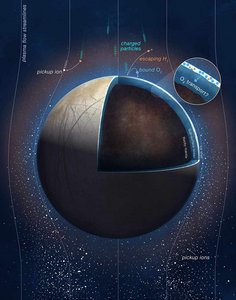Scientists with NASA’s Juno mission to Jupiter have calculated the rate of oxygen being produced on the Jovian moon Europa to be substantially less than most previous studies have predicted. Professor Dr Joachim Saur at the University of Cologne’s Institute of Geophysics and Meteorology was involved in the research. Saur provided calculations of the flows around the moon and contributed to loss rate estimates. The article ‘Oxygen production from dissociation of Europa’s water-ice surface’ appeared in Nature Astronomy.
With an equatorial diameter of 3,100 kilometers, Europa is the fourth largest of Jupiter’s 95 known moons and the smallest of the four so-called Galilean satellites. Scientists believe a vast internal ocean of salty water lurks beneath its icy crust, and they are curious about the potential for life-supporting conditions to exist below the surface.
The findings were derived by measuring hydrogen outgassing from the moon’s surface using data collected by the spacecraft’s Jovian Auroral Distributions Experiment (JADE) instrument. So far, Europa’s atmospheric composition had never been directly sampled. The measurements confirm that Europa has an atmosphere that is primarily made up of hydrogen and oxygen. The paper’s authors estimate the amount of oxygen produced to be around 12 kilograms per second. Previous estimates range up to over 1,000 kilograms per second. Scientists believe that some of the oxygen produced in this manner might work its way into the moon’s subsurface ocean and then could be a possible source of metabolic energy.
Jupiter’s magnetic field is responsible for oxygen erosion
Europa’s orbit places it right in the middle of the gas giant’s radiation belts. Charged, or ionized, particles from Jupiter bombard the icy surface, splitting water molecules in two to generate oxygen that might find its way into the moon’s ocean. While this constant bombardment is responsible for creating oxygen from water molecules in the first place, it simultaneously contributes to its loss by eroding water.
“Europa is like an ice ball slowly losing its water in a flowing stream. Except, in this case, the stream is a fluid of ionized particles swept around Jupiter by its extraordinary magnetic field,” said JADE scientist Dr Jamey Szalay from Princeton University (USA) and lead author of the study. “When these ionized particles impact Europa, they break up the water-ice molecule by molecule on the surface to produce hydrogen and oxygen. In a way, the entire ice shell is being continuously eroded by waves of charged particles washing up upon it.”
Capturing the bombardment
As Juno flew within 354 kilometers of Europa on 29 September 2022, JADE identified and measured hydrogen and oxygen ions that had been created by the bombarding charged particles and then “picked up” by Jupiter’s magnetic field as it swept past the moon.
“Back when NASA’S Galileo mission flew by Europa, it opened our eyes to the complex and dynamic interaction Europa has with its environment. Juno brought a new capability to directly measure the composition of charged particles shed from Europa’s atmosphere, and we couldn’t wait to further peek behind the curtain of this exciting water world,” said Szalay. “But what we didn’t realize is that Juno’s observations would give us such a tight constraint on the amount of oxygen produced in Europa’s icy surface.”
Juno carries 11 state-of-the-art science instruments designed to study the Jovian system, including nine charged-particle and electromagnetic-wave sensors for studying Jupiter’s magnetosphere.
“Our ability to fly close to the Galilean satellites during our extended mission allowed us to start tackling a breadth of science, including some unique opportunities to contribute to the investigation of Europa’s habitability,” said Scott Bolton, Juno’s principal investigator from the Southwest Research Institute in San Antonio. “And we’re not done yet. More moon flybys and the first exploration of Jupiter’s close ring and polar atmosphere are yet to come.”
Oxygen production is one of many facets that another NASA mission, Europa Clipper, will investigate when it arrives at Jupiter in 2030. The mission has a sophisticated payload of nine science instruments to determine if Europa has conditions that could be suitable for life.
Joachim Saur is a Co-Investigator on NASA’s Europa Clipper mission and ESA’s Jupiter Icy Moons Explorer mission. “These missions will leap our understanding of the oceans on these moons to an entirely new level. Both are dedicated missions to explore the oceans while Juno’s primary goals are to understand the interior and the polar lights of Jupiter and unfortunately had only one Europa flyby,” the geophysicist concluded.
Media Contact:
Professor Dr Joachim Saur
Institute of Geophysics and Meteorology
+49 221 4702310
saurgeo.uni-koeln.de
Press and Communications Team:
Eva Schissler
+49 221 470 4030
e.schisslerverw.uni-koeln.de
Publication:
J. R. Szalay, F. Allegrini, R. W. Ebert, F. Bagenal, S. J. Bolton, S. Fatemi, D. J. McComas, A. Pontoni, J. Saur, H. T. Smith, D. F. Strobel, S. D. Vance, A. Vorburger & R. J. Wilson,’ Oxygen production from dissociation of Europa’s water-ice surface’, Nature Astronomy, 4 March 2024
https://www.nature.com/articles/s41550-024-02206-x
More information about Juno mission:
https://www.nasa.gov/juno
